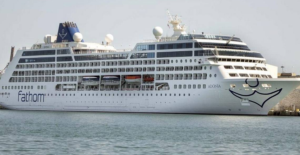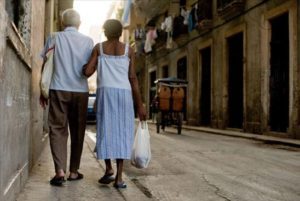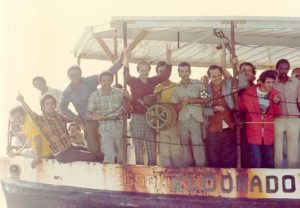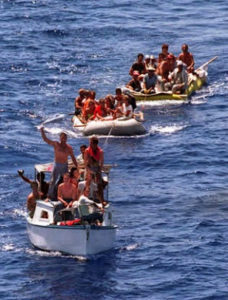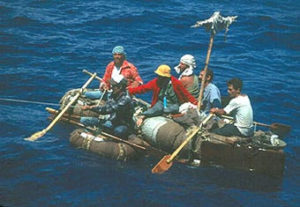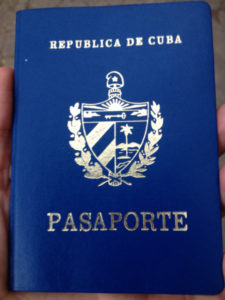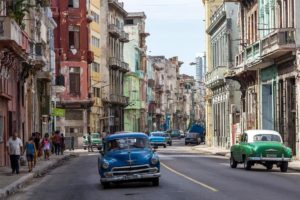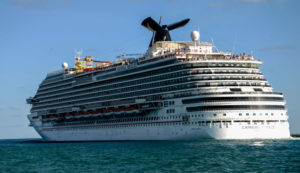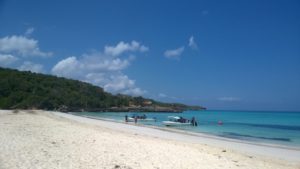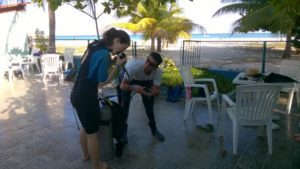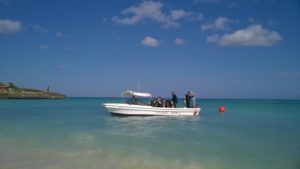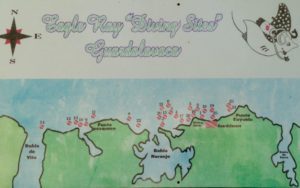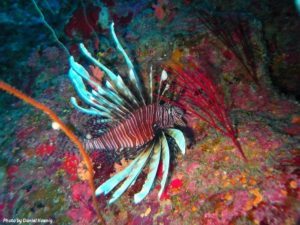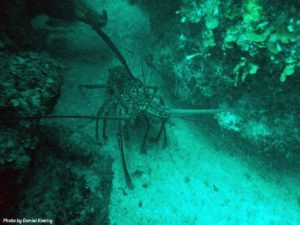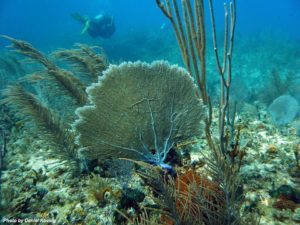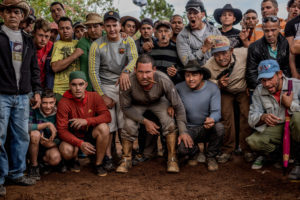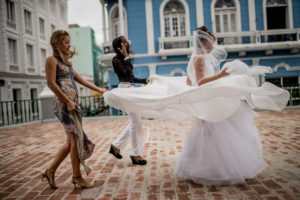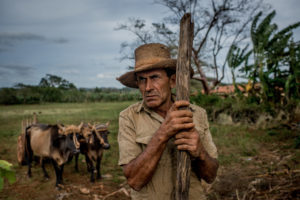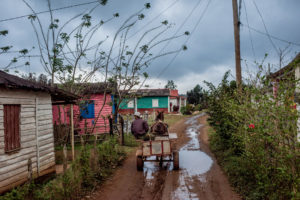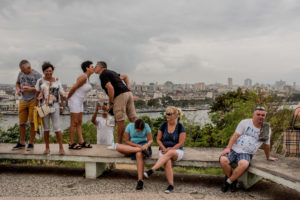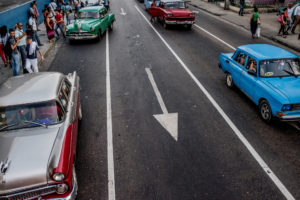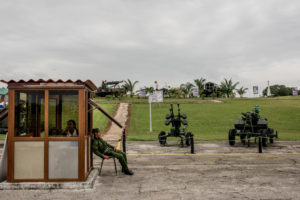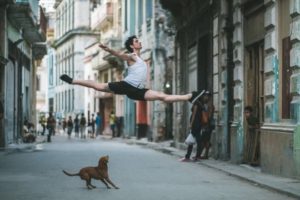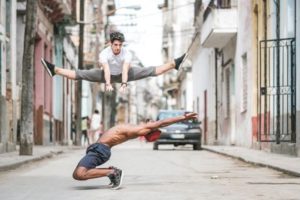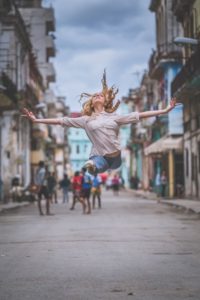Gerard Dion's Blog, page 21
May 7, 2016
The Real Lesson Learned From Carnival’s Cuba Odyssey
Gerard Dion Cuba Unchained
Friends,
The lifting of Cuba’s maritime travel ban this past week is the most concrete example we have to date of how normalized relations between the United States and Cuba are doing more to resolve differences between our countries and expand rights for the Cuban people than a half-century old policy of isolation ever achieved.
Despite what some in South Florida might claim, the lifting of the ban—which prohibited Cuban-born travelers from entering or leaving the Island on commercial vessels—was not the direct result of protests and lawsuits. Such actions against corporate interests seeking to do business in Cuba are not new to Miami, and in the past have only succeeded in deterring American companies from entering the Cuban market.
In this instance, public outcry certainly helped create a sense of urgency and its impact should not understated, though no more than it should be exaggerated. The fact is Miami-based protests and lawsuits have never persuaded the government in Havana to change a single one of its policies to the benefit of the Cuban people. Only one thing got us across that finish line last week, and that was engagement.
What made the real difference was that for the first time we had a mechanism in place to channel our frustration into constructive action; that Carnival’s attorneys and U.S. diplomats could sit down with Cuban officials and reach a resolution in an amicable manner.
It took negotiations, not confrontation, to actually secure the changes. And when you consider how slowly Cuba has moved to implement economic reforms and open up to American businesses, their announcement last Friday that they would lift the ban should be seen as a major advancement. Not because it flung the Island’s doors open—Cuban-born travelers have already been able to take flights to the Island for years—but because it showed how quickly the dynamics of relationship between the U.S. and Cuba are changing with increased personal and commercial ties.
Never mind the theatrics: After two weeks of controversy, a travel ban that had been in place for decades was lifted because both sides acknowledged it no longer served any purpose. Now if only the U.S. Congress would follow suit and end our own anachronistic laws toward Cuba, starting with the one that restricts the right of over 300 million Americans to travel freely to the Island.
On another note, pressure has also grown recently to do away with the Cuban Adjustment Act, including among lawmakers who still insist that we maintain the embargo on Cuba. While we agree that the CAA should be repealed, it must only be done so in tandem with the embargo. As we have previously stated, eliminating one and not the other is arbitrarily punitive to the Cuban people. We can never fully normalize ties if our immigration policy encourages thousands of Cubans to leave a country facing serious demographic challenges. But at the same time, we should not revoke privileges for migrants fleeing Cuba’s moribund economy while upholding blanket sanctions that contribute to the conditions they’re feeling in the first place.
If Congress wants to stem the flow of migration from Cuba, they can start by lifting the travel ban. After all, if the complaint from some Members is that economic opportunity—and not political asylum—is what drives this migration, then it only makes sense to adopt policies that foster growth on the Island itself. And if Congress wants more conducive relations, they should lift the embargo altogether. As we saw with Carnival, deeper economic ties with Cuba are a faster and more effective incentive for change than the embargo has ever been.
Finally, we want to congratulate U.S. Ambassador to Mexico Roberta Jacobson on her long overdue confirmation. For far too long, her nomination was held up as petty political payback for serving our country in diplomatic talks with Cuba. She has been an excellent public servant and we wish her the best in her new role.
Thank you for your support,
Gerard Dion Cuba Unchained
¡No Me Digas! Kardashians do Cuba–The World’s Coolest Place
Rep. Ileana Ros-Lehtinen Mocks Kardashian Family For Visiting Cuba. “As the Kardashians arrive in Cuba, some are questioning the impression of glamour they’re bringing to the financially struggling country. One outspoken U.S. representative had strong words on the reality stars’ trip to Havana. ‘I know it’s cool for celebrities to go to Cuba, but the Cuban people don’t experience the glamorous Havana that is featured on social media,’ South Florida Rep. Ileana Ros-Lehtinen tells PEOPLE in an exclusive statement. ‘Far from photo shoots and fruity drinks, everyday Cubans experience a different, sad reality.’ ‘Now, the Kardashians are parachuting into the island to tape their vapid TV show,’ she added. ‘Haven’t the Cuban people suffered enough?’” [People, “The Kardashians Arrive in Cuba as South Florida Rep Criticizes Their ‘Vapid’ Visit: ‘Haven’t The Cuban People Suffered Enough?’”, 5/4/16]
By Cox Media Group National Content Desk
HAVANA, Cuba —
The famous Kardashian family took advantage of the United States and Cuba reestablishing ties by flying to Cuba to film episodes of their E! Reality show, “Keeping up with the Kardashians.”
Kim Kardashian West, Khloe Kardashian, Kourtney Kardashian and family friend Malika Haqq posed for pictures around Havana, Cuba while documenting the trip for their show.
Kardashians do Cuba–The World’s Coolest Place
Thanks largely to Obama’s recent “engagement” Stalinist Cuba has quickly become the absolute COOLEST place on earth.
Close on the heels of Katy Perry, The Rolling Stones and the Obama family itself– this week Karl Lagerfeld showcased his Chanel “cruise line” with a fashion-show extravaganza where Havana’s Prado Street served as the catwalk/runway for the world’s coolest models while Gisele Bundchen, Tilda Swinton and Vin Diesel monkeyshined for the paparazzi on the sidelines.
Not to be outdone, the Kardashians just arrived in Havana to shoot their next show.
Gerard Dion
Cuba Unchained
The Consequences Of Emigration From Cuba
Gerard Dion Cuba Unchained
Cuba’s Population Projected To Decrease By Nearly 1 Million By 2025, Driven By Low Birth Rates And Emigration. “By 2025, Cuba’s population is projected to decrease by some 1 million residents. This dramatic demographic shift — from 11 million to 10 million inhabitants — is being propelled by low fertility and birth rates, as well as high levels of emigrations, according to experts who met recently at Florida International University. Cuba also will continue to have the oldest population in Latin America. Today, 19 percent of the island’s population is older than 60, the expertssaid, and forecasts point to that number rising to 30 percent in less than a decade.” [InCubaToday,
“Cuba’s population expected to drop dramatically over the next decade,” 4/30/16]
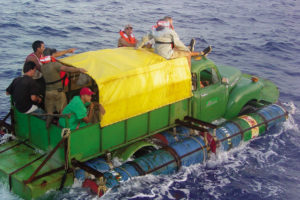
STRAITS OF FLORIDA (July 17, 2005)–Eleven Cuban migrants attempt to reach the United States on a Chevy flatbed truck rigged with pontoons, in the Straits of Florida. USCG photo by Fireman Greg Ewald.
People Who Emigrate From Cuba Tend To Be “In The Prime Of Their Productive And Reproductive Lives. “‘Developed countries have low infant mortality, birth and fertility rates, but their populations don’t drop because they receive immigrants,’ Aja said. “But that’s not the case of Cuba.’ Until the end of the 1930s, Cuba received migrants. But since then, emigration has been sustained, with spikes during mass exodus events in the 20th Century — the Mariel boatlift in 1980 and the Rafter Crisis in 1994 — and more recently the flow of Cuban migrants through Central America and Mexico on their way to the United States. ‘Cuba cannot compete on migration even with the Dominican Republic,’ Aja said. One of the island’s main problems is that the people who emigrate are generally the youngest, in the prime of their productive and reproductive lives.” [InCubaToday, “Cuba’s population expected to drop dramatically over the next decade,” 4/30/16]
Panama Set To Expel Thousands Of Cuban Migrants Making Their Way To The U.S. “Following in Costa Rica’s steps, Panama is planning to expel thousands of Cuban migrants currently stranded in the country on their way to the U.S. A Foreign Ministry official said earlier this week that some 3,000 Cubans will be transferred to a facility near the border with Costa Rica in preparation to fly them to Mexico. Then it intends to close its borders to migrants from the island nation, according to In Cuba Today, the way Nicaragua has. More than 670 Cuban migrants are already housed in the border facility, called Los Planes shelter. At least a hundred more are now in detention on the Colombia border.” [Fox News Latino, “Panama to expel more than 3,000 U.S.-bound Cubans stranded on its border,” 5/4/16]
The Next President Will Support Ending The Embargo. But Why Wait?
Gerard Dion Cuba Unchained
Friends,
If there was a chance that the incoming administration would be in favor of keeping the embargo, as of this week, that chance was effectively reduced to zero.
Sen. Ted Cruz and Gov. John Kasich both dropped out of the GOP primary race this week, and with them went any remaining opposition to normalizing relations with Cuba among presidential candidates. Donald Trump has spoken in measured support for normalization, and former Secretary of State Hillary Clinton and Sen. Bernie Sanders are all in favor of a full opening.
In Washington, the influence of the pro-embargo hardline will only lessen in the months ahead. Sen. Marco Rubio, the most prominent anti-engagement member of the Senate, is leaving office at the end of his term. Cruz will return to the Senate, but the notoriously unpopular senator’s odds of marshalling his colleagues in support of the embargo are about as good as, uh…Lucifer’s.
When it comes to current Cuba developments on the Hill, members should take note of the contrast in directions between the pro- and anti-engagement coalitions. As of last week, Sen. Jeff Flake’s bill to lift the travel ban is now cosponsored by nearly half the Senate, and Rep. Mark Sanford’s counterpart in the House has passed over 120 cosponsors. Meanwhile, the pro-embargo wing—once able to dictate foreign policy to presidential campaigns—has now been reduced to attacking Kim Kardashian for traveling to Cuba. Because demanding an investigation into Beyoncé’s completely legal Cuba trip a few years back was not a sufficiently embarrassing waste of taxpayer dollars.
That is where we are in 2016. One bipartisan coalition in Congress is working on policies that will benefit both the Cuban people and their constituents, while another dwindling one is co-opting the work of late night talk show hosts to attack private citizens for where they choose to travel. So far, the pro-embargo hardline has been able to successfully prevent any further opening to Cuba by peddling the idea that things might turn around with the next administration. We know that now to be a fantasy. For the sake of the Cuban people, it’s time Congressional leadership did as well. The time to act is now.
Thank you for your support,
Gerard Dion
Cuba Unchained
April 25, 2016
How Tourism Will Change Cuba
Gerard Dion CUBA UNCHAINED http://www.cubaunchained.com/
How Tourism Will Change Cuba http://www.cubaunchained.com/
In 2015, a record number of people traveled to Cuba. Here’s a look at how mass tourism is likely to change the famously sheltered island.
President Barack Obama, the Rolling Stones, and Major League Baseball: March 2016 was a busy month in Havana.
After more than a half century of chilly relations between the United States and Cuba, the Caribbean country has moved from an outlier travel destination to top of mind. More than three million people—a record—traveled to Cuba in 2015, with visits by U.S. residents growing by 77 percent.
How will this influx of outsiders change the famously sheltered island?
Infrastructure projects are in the works, though many lack outside financing, and international hotel groups are champing at the bit to get in the game.
But development backed by U.S. dollars hinges on two things: the Cuban government’s willingness to give the green light to American investors—provided the country is able to make its economy transparent enough for them—and the U.S. Congress gaining enough support from the public to lift the embargo in the first place.
Who knows when these things will happen.
In the meantime, though, increased tourism to the island—and the money it brings—is fueling the growth of entrepreneurism there, and that seems to be having a positive effect.
With demand outstripping supply, space has opened up for small privately owned businesses to act as catalysts for change in the world of restaurants, homestays, and B&Bs. Here’s a look at how tourism is likely to bring about a revolution—albeit a slow and subtle one—in Cuba.
The Rise of Paladares
By international standards, Cuba is no foodie destination. But that’s changing in Havana, the country’s culinary heart.
Despite local chefs having little means, other than the Internet, of learning from their peers in other countries, new paladares (privately owned restaurants) keep popping up, offering a welcome alternative to government-controlled restaurants that depend on food rationing and allowances.
Tamar Lowell of Access Trips—which launched culinary tours on the island in 2015—has noted increased competition among restaurants and a surge in self-employed street food vendors over the past year, especially in Old Havana. “We are hearing that some of the top paladares are booking [up] weeks and even months in advance,” Lowell reports.
She’s also seen firsthand how the rise of paladares has improved the quality of food for visitors (and locals who can afford it).
Lowell points to Finca Marta, one of the stops on her company’s tours, as an illustration. Without paladares, there would be little demand for the organic produce Fernando Funes Monzote grows on his 20-acre farm just outside Havana. But as travel to Cuba explodes, chefs are encountering tourists whose expectations go beyond the staid pork and plantains fare that’s given Cuba a reputation for uninspired cuisine.
As a result, Funes now supplies greens and vegetables to many of the top private restaurants in the city and is helping to lead the call for a homegrown resurrection of farming in Cuba. (The country continues to import up to 80 percent of its food due to a failed state-run agriculture model that President Raúl Castro has been working to address.)
An Airbnb Revolution
On the housing front, private homestays—many listed on Airbnb andHomestay.com—have proliferated to bridge the gap between Cuba’s current hotel capacity and the number of rooms needed to meet ever increasing demand.
One case in point: Airbnb now has more than 4,000 listings in 40 different cities around Cuba—a threefold increase since it launched operations there in April 2015.
“Airbnb stays provide some of the most culturally diverse and immersive people-to-people experiences on the island,” says Jordi Torres Mallol, the company’s regional director for Latin America. “We’re making it easier for local hosts to showcase Cuba’s unique hospitality by welcoming travelers from around the world into their homes,” he adds.
But that’s not the only perk they’re receiving. Mallol reports that hosts earn an average of $250 per booking, significant income in a country where the average salary is less than $30 a month. (Though it must be noted that the cost of living is also quite low due to government subsidies, lest this become a treatise on the superiority of laissez-faire capitalism.)
Infrastructure in Flux
As the end of the embargo looms, American investors are lining up to claim their piece of the tourism pie in Cuba.
For now at least, Starwood is the first U.S.-based hotel chain to get its foot in the door. In March 2016, the company inked an agreement to take over operations at three Havana hotels: Hotel Quinta Avenida, in the city’s posh Miramar district, will woo the business travel set, while Old Havana mainstays Hotel Inglaterra and Hotel Santa Isabel will be transformed into luxury boutique properties.
Havana has also given the green light to passenger cruise companies based in the U.S., including Carnival, which has spring departures planned, provided Cuba changes its policy barring nationals from returning by sea.
And, as is the case with Havana’s airport and hotel infrastructure, the city’s port stands to be swamped by projected visitors.
There are rumors of a new cruise ship terminal to be built in Havana’s historic harbor, but no definite plans have been confirmed. “Any major changes will take a while, because these are very complex situations,” says Molly Danner of National Geographic Expeditions, which has been leading trips to Cuba under a person-to-person license since Obama reinstituted legal travel to the island in 2011. “There are many constituencies that have to agree on what needs to happen.”
But while accessing Cuba by cruise ship presents one way of getting around the dearth of quality accommodations and dining options on shore, it means fewer American dollars will seep into the newly reinvigorated private sector economy.
The Future Predicted
While Americans traveling with groups benefit from long-standing “fixer” relationships between tour companies and local operators, the impending influx of independent travelers with higher expectations, combined with a lacking service sector resulting from decades of a planned economy, could lead to a dampening of enthusiasm among Americans once the initial boom has subsided.
A rueful shrug and “this is Cuba” is not going to cut it for long, especially if you’re paying international prices. But given time and training, the island’s hospitality and service infrastructure will build upon the warm and vibrant culture of its people, making Cuba a compelling destination for travelers everywhere.
Gerard Dion
Cuba Unchained http://www.cubaunchained.com/
Cuba Just Opened the Door for Carnival Cruise Ships to Sail to Havana
Carnival’s May 1 cruise, the first from the United States to the Communist-run country since the 1959 revolution, was thrown into doubt when the company triggered a backlash by refusing Cuban-Americans passage due to a Cold War-era law.
A statement carried by state-run media said that starting April 26, Cuban citizens would be authorized “independently of their migratory status to enter and leave as passengers and crews of cruise ships.”
Carnival received approval from the United States last year to sail to Cuba, and the green light from Havana a day after U.S. President Barack Obama’s historic visit to the country in March.
The waters between the two countries have been the scene of mass migration, hijacking and other crimes in the past, leading Cuba to ban Cubans from traveling by boat without special permission, even though restrictions on traveling by air were lifted years ago.
Protests in Miami, where the company is based, a discrimination suit and criticism by Secretary of State John Kerry led Carnival to start accepting bookings from Cuban-Americans earlier this month.
The company said it would postpone the cruise if necessary, but also expressed confidence Cuba would rescind the law before its first “Fathom” adventure, which is expected to begin sailing to three Cuban cities every fortnight from May 1.
Cuban-born Americans are free to enter their homeland by air, with around 300,000 arriving every year.
The statement on Friday said authorities were also reviewing a ban on citizens from boarding recreational vessels such as fishing boats and yachts.
April 21, 2016
CUBA: A GREAT PLACE TO GO SCUBA DIVING
By Gerard Dion author of CUBA UNCHAINED
Until a little over a year ago I could have never imagined I would become a scuba diveaddict… Diving was something my husband Frank had dreamed about for years, but truth to tell, the idea of going diving scared me!
I was afraid I would feel claustrophobic being completely surrounded by water. I couldn’t have been more wrong, diving doesn’t feel claustrophobic to me at all! In fact, it’s quite the opposite: it feels like ultimate freedom!
I love flying over the beautiful coral, surrounded by colorful fish, spotting the occasional turtle or stingray while hearing nothing but the sound of my own breathing.
Since getting my PADI Open Water in the Philippines, I have explored the underwater world in Malaysia, Thailand and now Cuba!
Diving in Guardalavaca
I had read about the many diving possibilities in Cuba but I wasn’t sure if there would a dive center near Guardalavaca where I was staying for the majority of my time in Cuba. Luckily there was, located on the beach 300 meter from my hotel, Club Atlantico.
Dive school
The dive center is called Eagle Ray Marlin Diving Center and when I visited (March 2016) it was opened every day. There are usually 2 dives a day: at 9am and 11am.
I went diving on Saturday (I went on both the 9am and 11am dive) and Monday (I went on the 9am dive only).
On Saturday there were just 4 people on the dive and 2 dive masters. Since it had been more than 9 months since my last dive, I very much appreciated dive master Alejandro helping me putt my gear together properly. Don’t get me wrong, I assembled my own gear (very important to check your own stuff and know if everything works!), he just gave me some pointers on things I forgot.
On Monday there were a lot of people, so we split up in 2 groups of 7 people. I didn’t mind the larger group size that much, however I do prefer smaller groups (4 people per dive master). Ah well, the awesomeness of my Monday dive more than offset the slightly higher number of people being on the dive.
I paid 90CUC for 3 dives, which comes down to 30CUC per dive (around €26/$30). The more dives you do, the lower the price per dive.
Dive sites
There are 26 dive sites in front of the beach of Guardalavaca, I went to 3 of these dive sites:
• Sirena
• Coral Garden
• LaberintoWhat surprised me was how close the dive sites were to the shore. Just 5-10 minutes on the boat and I could pretty much wave to my mum (who I traveled around Cuba with:-) who was relaxing on the beach.When I asked one of the Dive Masters about his favorite site he mentioned Laberinto (lucky me that we went there:-). In the Lonely Planet of CubaCorona is also mentioned as a nice dive site.
Sirena
The Sirena dive site is between 18 and 40 meter deep and it was my first wall dive! I have to admit it took me a while before I was able to fully enjoy my surroundings as it had been more than 9 months since my last dive. Diving isn’t difficult, but you do get better the more often you do it.
I had to refresh my skills during the first part of the dive and get back into the routine of breathing slowly, moving slowly and checking my dive console for information about my air and depth. Once I had gotten back into my ‘dive groove’ I was wowed by the impressive coral formations on the steep wall.
Highlight of the dive: my first wall dive and seeing 2 lion fish!
Coral Garden
Being the second dive of the day, this was the shallow dive, between 6 and 15 meters deep. What I love about shallow dives is how the sunlight filters through and sparkles off the colorful fish.
Another reason I like shallow dives is because I get cold quite easily. Well, that may be an understatement. My husband would say this is a severe understatement, he sometimes calls me his little vampire… I don’t know why, but my body sucks at maintaining a proper temperature.
But I am rambling, back to diving. When I am diving in water below 26 degrees Celsius I get cold. Last year in El Nido the water temperature was round 24 degrees Celsius and I couldn’t stop shaking when I got out. I actually started wearing 2 wetsuits, a long one and a short one on top of that, following the advice of my awesome instructor who had the same problem…
Unfortunately, there was only a short wetsuit available in Cuba and after the first dive at Sirena I was cold. Brining my to my second point (finally;-) why I like shallow dives: it’s a little less cold at 12 meters than it is at 30 meters. Warmer and lighter.
By Gerard Dion Author of CUBA UNCHAINED
CUBA ON THE EDGE OF CHANGE
CUBA AT TIMES can feel like a nation abandoned. The aching disrepair of its cities, the untamed foliage of its countryside, the orphaned coastlines — a half-century of isolation has wrapped the country in decay. Yet few places in the world brim with as much life as Cuba, a contrast drawn sharper amid its faded grandeur.
They wait, coiled with anticipation. For web pages to download. For tourists to hurry up and buy something. For a flag to be raised. Cubans know how to wait. Yet, after decades of Communist rule, they are less prepared to handle the feeling of opportunity now permeating the island, and their government’s resistance to letting them seize it.
Breaking out of Havana is essential, eye-opening, often impossible. Flights are irregular, leaving in their own good time — if at all. The search for a car that can handle the gouged roads and aged infrastructure will plumb the depths of your patience. The effort, though, is worth it. The country yields all the complexity, beauty and idiosyncrasy of one of the world’s few remaining frontiers.
The revolution is over. It has been for decades. Not that you would know it from the rhetoric or the adulation bestowed on this slice of Cuban history, at least by Communist Party leaders. But when the sound waves subside and the propaganda quiets, what you find is a military clinging to historic relevance, with an uncertain place in today’s Cuba. Like much else there, its aging weaponry and upper ranks have been sealed up in a time capsule for more than 50 years.
The trappings of the past are literal in Cuba — the ancient Chevys, the faded posters of Fidel. It can, at times, seem studied, a museum of quaintness, until you need a ride somewhere and come to realize that these classics, not meant to be cute, are vital transportation for the Havana masses. Or you realize that the posters cling to the walls of a former revolutionary’s home, the charm only incidental.
Tourism is inescapable in today’s Cuba. Selfies on the Malecon. Shots of classic cars. Che T-shirts. For Cubans, this is for now the highest rung in the emerging economic order, one of the few ways to break free of monthly salaries that could scarcely pay for an hour of parking in Miami. Cubans scrape together what they can to offer services outside their areas of specialization. Here, doctors drive cabs, engineers hawk tamales and working farmers hustle to sell a horse ride to travelers.
In a land of iconic imagery, perhaps no images are more revered, marketed or pervasive than those of the nation’s revolutionary heroes. Ground zero for this iconography is the Plaza de la Revolucíon. The black outlines of Fidel Castro, Ernesto Che Guevara and Camilo Cienfuegos grace the walls of buildings flanking the plaza, their images looming large over the heart of the nation.
Though Cuban society has been closed off from the world for a half-century, there remains an uncanny openness about the nation’s people. Pop into a random apartment and the worst you may get is a wary stare, followed by a joke. Cubans seem inoculated from the preoccupation with privacy that infects other countries. Life is lived in public here, doors cast open to the night, beckoning the passers-by.
By Gearard Dion author of CUBA UNCHAINED
Photographer captures stunning photos of dancers in the streets of Cuba
On his recent trip to Cuba, photographer Omar Robles captured remarkable snapshots of ballet dancers expressing their art throughout the nation’s culture-filled streets.
With 135,000 Instagram followers, Robles is known for his stunning photographs of dancers performing against cityscapes and urban backgrounds.
Robles told Mashable that visiting Cuba has been a lifelong dream. While he was there, he had the pleasure of getting to know some local dancers.
As he mentioned in his blog post, Cuban dancers are some of the best trained in the world — which is another reason he was eager to visit.
Dancers can make anything around them look beautiful.
Photographer Omar Robles, 34, has made that the theme of his work. Based in New York City, he takes stunning photographs of dancers set against gritty urban backdrops. Subway cars, alleyways and the streets of the city all serve as a playground for the dancers he captures.
“I’m in love with how you can express and create all these beautiful lines and movements with just the human body,” he tells Mashable.
Robles got his start in the art world studying mime theater, later discovering photography as a college student. About 42,000 Instagram followers later, Robles is a bonafide photographer with an eye for striking dance portraits, and a dedicated social media following.
Here are just a few examples of his dance-centric work. Robles says that these dancers are following their passions with great pride — and that their attitudes truly struck him in a life-altering way.
Gerard Dion
April 8, 2016
Keeping faith in the business when a leader’s health fails
 http://www.sbnonline.com/article/keeping-faith-business-leaders-health-fails/
http://www.sbnonline.com/article/keeping-faith-business-leaders-health-fails/
By: Gerard Dion | 12:01am EDT April 1, 2016
My career in the automotive industry spanned several decades and includes experience working for a major manufacturer as a marketing executive followed by becoming a franchise dealer of my manufacturer in one of the largest cities in the United States.
I worked hard to learn everything I needed to know to be successful as an employee and as an entrepreneur. In this process I contracted colon cancer and later on heart disease. Both of these problems are life-threatening and require invasive surgery and long recovery, if you’re lucky.
Furthermore, their seriousness requires that you and your family and in this context your employees and their families plan for the worst and hope for the best. Personally facing your own mortality is a daunting exercise to say the least.
Secondly, planning the succession or sale of your business and security of your employees are equally challenging. However, these issues must be resolved personally while you keep the ship at home and at work on an even keel in high winds and waves perhaps successfully in a period of months.
I have weathered this hurricane twice, and I wish to share with you what I observed and learned while trying to retain confidence and optimism in the future of my enterprise during these extended periods of deep concern and doubt by all the key stakeholders.
Number one. I discovered early on that no one including some in my immediate family knew how to talk to me anymore. I therefore came to understand that as the afflicted, I had to help these people bridge the communication gap. So I stopped thinking about myself and started trying to heal them. This tactic worked for them and for me.
Number two. I accepted visitors in the hospital the day after both operations. I remained jovial, communicative, optimistic; regardless of how I felt during these visits. I called department managers every couple of days to follow up on current opportunities or problems. I stayed involved day-to-day.
Number three. I got back to a daily work schedule almost immediately, including a period of seven months of weekly chemotherapy treatment. I never missed working a day after the first two weeks following the colon operation.
Obviously these basic ideas work best if prior to any business disaster you have established a culture of mutual trust and respect, appreciation and loyalty.
The aforementioned health issues are now in my distant past, and my health and mental outlook remain good. I continue to work in semi-retirement mode and have helped several of my employees to transition their major health problems and return to work or retirement.
Life is good and so is business.
Gerard Dion is a U.S. Marine veteran and self-employed marketing executive with an extensive background in the automotive industry and defense and many years of experience with a Fortune50 corporation. He has overcome both cancer and a three-way heart bypass. Long a proponent of U.S.-Cuba reconciliation, Dion has written his first novel, Cuba Unchained, about the relationship between the two countries.

